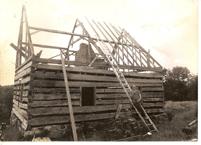
Building the Gemeinehaus (community house) in 1994 from a building originally constructed in 1758. We moved it 85 miles from Bethlehem, Pennsylvania to the Hermitage, where we rebuilt it.
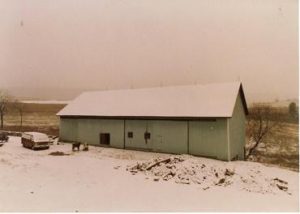
Early 1989. We spent the first two winters in the barn, the only building on the property when we bought the land.
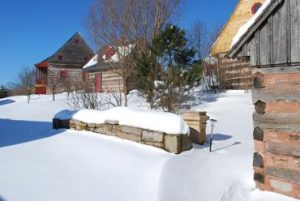
The first four log buildings we constructed. Left to right, the Gemeinehaus, summer house, First House, and outhouse.
Author: Christian and Johannes Zinzendorf
Published in Communities Magazine Issue #154
Every community starts somewhere and ours started in a barn, the only remaining building on the 64-acre tract when we bought it in 1988. Due to what could charitably be called our limited resources, we could either afford a house and no land or land and no house. The choice was simple though we quickly realized that our drafty barn was no place to spend a winter in the mountains of central Pennsylvania. We ended up huddling around a kerosene stove inside an 11-foot travel trailer we pulled inside the barn, giving personalized meaning to cabin fever.
Still, we soldiered on, knowing our early Moravian brothers and sisters had started their own spiritual community at Bethlehem in the Lehigh Valley in a log structure that combined living quarters for humans and livestock. As we acquired our own sheep, oxen, and goats, they lived below us in the stable. At night we heard them moving around in their stalls. Even their body heat came up through the floor boards and their proximity formed both bond and family.
The land was barren fields at Thanksgiving when we first inhabited the property. With mountains bordering the southern and northern sides of our valley, we were on a wind-swept ridge running down the center of the valley, nakedly exposed to fierce winter winds that howled across the land, often driving snow horizontally. Our Scottish nature even then realized there was an enormous amount of wasted energy here that only many years later would we be able to capture with a wind turbine.
Our mission was clear: we build our vision and brothers will come. After all, we were recreating an 18th-century religious community of single brothers that at its height had nearly 90 men and youth. It took years before we realized that the early settlement, also in the Lehigh Valley, had one thing we did not have: a charismatic leader to whom followers flocked. Actually, we weren’t looking for followers as much as equals who shared our vision of an earth-centered spirituality. The only trouble, in addition to having no charisma, was that our spirituality was always in a state of flux. We were criticized for making it up as we went along but actually it was constantly evolving. Instead of “making it up,” which implied some kind of random searching for whatever worked, we saw ourselves as a radio telescope, constantly fine tuning the direction of our antenna to pick out faint signals from whatever distant galactic nebula we were receiving them. Or, in another analogy, we were trying to pick out images through a darkened glass. It was there, fully formed, we just couldn’t see it clearly.
Still, as the years went by and potential brothers came and went, it is true that our attempts to form a cohesive vision that would attract brothers became increasingly scattered as we became desperate to find some bait that would attract them like hummingbirds to sugar water. Those years were not among our better efforts as we pandered to whatever we hoped would work in getting brothers to join us. At one point, angels were the hot thing in popular culture, so we called ourselves the “guardian angels of the garden.” We did see ourselves as stewards, but the angel thing was capitalizing on a trend that, as with all our other attempts, failed to generate the hoped-for response, meaning we were still alone.
During these years we moved abandoned log and timber-frame buildings from valley farms to the Hermitage as we created the physical version of our internal vision. At one point our early Moravian brothers and sisters had constructed their own version of New Jerusalem, the heavenly city of Revelation that descended to the new earth. The Moravians called their German community Herrnhaag, God’s Grove, and they believed it was ruled by Christ working through our own charismatic founder, Christian Renatus Zinzendorf, leader at that time of the Single Brothers. Our own vision was that of creating a new Eden, pictorially represented in the series of paintings by Quaker painter Edward Hicks called the Peaceable Kingdom in which he showed Pennsylvania founder William Penn signing a treaty with the Delaware Indians, surrounded by images of peaceful coexistence among supposedly natural enemies, the lion laying with the lamb, the child holding a snake.
When the followers of Christian and his father, Moravian leader Nicholas Zinzendorf, came to Pennsylvania in the 1740s, they created cultured Germanic towns in the wilderness where music by Bach as well as the Moravians’ own composers was played while German-trained artists built pipe organs, painted portraits, and constructed enormous stone buildings. It was these buildings that initially attracted us to what we learned were spiritual communities in which the traditional nuclear family was replaced by a communal family whose daily lives were dedicated to serving Christ. The buildings we admired were basically dormitories where members were separated according to gender, age, and marital status. Actually marriage consisted of the entire community seen as the Bride married to the Divine Bridegroom. Both men and women were married to Christ in this way and the homoerotic implications were obvious to us even if downplayed and vehemently denied by two centuries of church apologists. That didn’t faze us as we knew what those men were really up to in their multi-hour love feasts in which the spiritual and the physical grew together and fused in harmony. That’s what we wanted to recreate and we felt driven to achieve it once again.
This merging of the physical and spiritual was reflected in the daily lives of our early brothers and sisters, just as we wanted it to be reflected in our own lives. That meant our very behaviors had to reflect the inner harmony we were seeking and that we wrote about and sang in our hymns. It was also reflected in the objects of our daily lives just as it had been in the objects of the early Pennsylvania Germans, for whom beauty and utility merged in the shape and form of a spatula, a bed, a building, a book. We insisted on living in a physical world imbued with spiritual beauty where nothing was mundane and every object was a reflection of the divine.
Well, it sounded good but the reality was harder to achieve, especially as we were starting from scratch and basically with almost nothing: no money, few skills, and fewer tools, just boundless enthusiasm, energy and, when all else failed, grim determination. We forged ahead on all fronts, crafts, buildings, agriculture, livestock, printing, developing our spirituality, all with no running water, no electricity, no plumbing, and no help. But we didn’t care. We would do it all because we knew it was only a matter of time before brothers flocked to join us. Boy, were we crazy. What we learned is that when you scream in the Mahantongo Valley, no one hears you and, if they do, they don’t care. But then, why should they? Not one of these insular Pennsylvania Germans (not Amish, keep in mind; these were more worldly Lutherans and Reform Germans) asked for two gay city slickers to move in among them. Initially they thought we might be going to subdivide the farm, an idea anathema to farmers who had kept some of the surrounding land in their families for two centuries. In retaliation for that idea, the signs we put up at each end of the property with the community’s name, not that of a subdivision as was erroneously supposed, were stolen within days of our putting them up.
The other idea was that we were drug dealers moving here to grow marijuana. To test that idea we were subjected to overhead helicopter flights using infrared cameras looking for the vile weed. The locals were probably disappointed to learn we were clean, at least in that respect. The strange looking crop we were growing was flax, not hemp. We explained that their earliest ancestors on this very land had grown flax for their linen cloth and linseed oil. That interested a few but to the rest it was just another example of our weirdness. For example when we were plowing one day with our oxen, a neighbor stopped by to watch us. At the same time a jet plane was flying overhead with its long vapor trail streaming behind it. Pointing to the plane, he said, “There’s the future. You guys are the past.” And then he drove off. Our neighbors respected the past but weren’t controlled by it. Eventually neither were we, and for the same reasons: practicality and ease. But first we had a lot to learn.
Johannes learned just how far removed we were from modern life when he started selling our homemade bread at the local farmers’ market. One of the first structures we moved to the property and rebuilt was a 200-year-old brick bake oven from an adjacent farm. Johannes taught himself how to use it and how to bake traditional round loaves of sourdough bread using rye-straw baskets and dough boxes. In a desperate attempt to make money (having been understandably fired from his newspaper job for spending too much time on Hermitage business while on company time) he baked three days a week and sold the resulting breads, cakes, cookies, and pies at market on the fourth day. In a good week he was lucky to net $100 after paying for his supplies. The problem was one of public perception readily summed up by an elderly gentleman who, every week without fail, would stop at Johannes’ stand, stare at his loaves of bread and say, “Those are the ugliest things I’ve ever seen.” Johannes wasn’t fighting customer apathy here as much as customer ignorance. The man’s great-grandmother had made loaves just like the ones Johannes was trying to sell but the man was so far removed from his past that he had no idea what he was looking at except to vocally declare he didn’t like what he saw.
But not all interactions with our neighbors were bad. One elderly woman brought by a handmade comforter used by her and her husband when they were first married. “It kept us warm and it will keep you warm, too,” she said. And she was right. It was her generation, the one raised before World War II, who understood what we were doing because they, too, had lived without electricity, plumbing, or running water. She and her husband pulled their water by the bucketful from the ancient hand-dug well on their property just as we did from our own. No, what misunderstandings we had came from those of our own generation who could not figure out why we lived the way we did, why we consciously gave up what they viewed as necessities. To us all work was holy so drawing water by the bucket was simply part of our credo and ethic. The only problem was that eventually we were overwhelmed by the accumulating weight of such holiness.
As for expanding the size of our community, we did try. Time and again potential brothers came and left when the reality of our lives did not meet their needs and hopes. Other times we kicked them off when their reality did not meet our hopes and needs. The resulting continued loneliness wore us down and we constantly had to readjust our vision for the community based on the increasing realization that we could not do it all. While the tools of colonial-era agriculture are few, such as a single-moldboard plow, a scythe, a spiked-tooth harrow, a wooden-wheeled hay wagon, they are labor intensive. Our first spring, Johannes stood with his scythe facing a seven-acre field of hay. He cut a 50-foot swath, wore out, and realized the limitations of labor-intensive farming when there is a lack of labor. Our early brotherhood had dozens of men and youth cutting hay and wheat in the fields while musicians played hymns to spur them on. A potential brother offered to sing hymns while we worked, becoming offended when we explained we could better use his help holding a scythe rather than his accordion.
For that reason we sold the ox team to buy a tractor. We went from bringing in loose hay to baling it. We added technology, rapidly recapitulating generations of agricultural advances to make up for the lack of brothers, the lack of shared labor. Eventually we came to the realization that farmers are born, they’re not made, and we were ready to pass that work to a neighboring farmer when he offered to farm the land for us and share the crops. That’s the same reason we gradually got rid of our livestock, our beloved cattle, goats, hogs, and sheep, our extended animal family, because we simply could not maintain them any longer.
As men came and went, it was always just the two of us to do all the work—construction, farming, crafts, animal husbandry—in addition to the daily maintenance of our lives, the cooking, cleaning, washing. After a full day of labor, we had to face making a meal and then finally tumbling late at night into bed, exhausted, too often cranky, angry, frustrated, and we too often took it out on each other to the point where we ended up living apart just to stay together.
As the reality of our aloneness set in over a space of years, our own needs changed. As we finished the master building plan, we started converting cottages once designed for residents and visitors into studios for our own artistic production. Instead of using the property to host gatherings and workshops for the creativity of others, we ended up resenting the time it took to be hosts and started nurturing our own creativity. Our private artistic needs burst forth as the public building phase ended. It turned out that sharing our vision was impossible and never worked out. We were as critical of others as they were of us. It took many years to realize we are not communalists but hermits. We went from being a cloistered brotherhood to a hermitage.
As we have grown older, and now we are into our third decade here, we have sought ways to make life easier, to free us to do the work we want to do, not the work we feel we have to do. That work is basically done. So we have added the technology we once eschewed such as calling the power company to hook us back up where once we called to have the lines taken down. What irony that was. Now we have indoor plumbing and running water and we don’t even have to run outside to get it. We can sit in a house, writing at a computer, listening to music while being warmed by propane heat. The days are gone when we had to come home from work and scrounge through the snow for bits and pieces of wet wood to burn. And what a joy that is.
It’s late at night. Dogs are on the bed. Outside, two owls form a stereophonic duet, hooting to each other. The dream of brotherhood is dead, replaced with a passion to create beauty and spiritual harmony for as long as we can sustain ourselves independently. After that, we don’t know. We can always donate the Hermitage to a local nonprofit organization. Meanwhile the vision of our founder sustains us. He saw New Jerusalem coming to earth and lived in that state of grace until he died in London in 1751 at the age of 25. Many young men must have died in London that year. But only he came back to life in the waters of a spring in Pennsylvania. That merging of the physical and the spiritual, that creation of harmony and wholeness, continues to sustain and guide us.

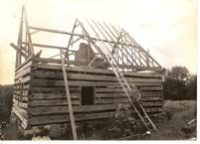
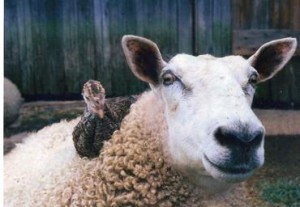
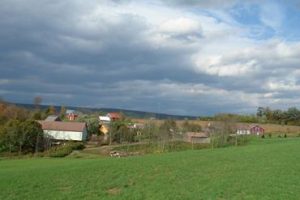

















Charlesalban
This is the fundamental problem with all intentional communities. There is way too much work to do for a small group. That’s why we have all these labor-saving gadgets… because we don’t have the people to do the work. I’m a member of the New Vrindavan spiritual community in West Virginia. We went through all the simple and primitive living back in the 60s and 70s. There were over 700 people living here at its height in the early 80s. But most of them left as soon as they started getting married and having families. Any intentional community that wishes to grow and survive for the long haul must devise ways to retain and meet the needs of young families. The Amish are particularly successful at this. Their average family size is seven children, of which they retain 80%, and their population doubles every 20 years. They have learned how to take care of the needs of their young people. This is the model that needs to be followed.
jeanmarie
Oooo boy, The things we do to feed our fantasy at the expense of sanity! Back to the land in 1973 for me was fraught with the same kind of peril. I burned down to a weak kernel of flame in ten years…physically, mentally and spiritually exhausted. Now, thirty years and a bit more secure I find myself revisiting that worldview I held in the ’70s. I will invest my energy and talents in an effort to assemble my community. This time better prepared and informed…thank Goddess for the www!
Ok, my hat is off to you guys. Ya rolled the dice and accepted their faces up. And you evolved in a manner suitable to your spirits and circumstances…I admire your grit.
best wishes to ya,
jeanmarie